 Everyone needs a good laugh from time to time and books with wordplay can provide just that. This week’s column from the International Reading Association's Children’s Literature and Reading SIG offers books that look at words in new ways. Wordles, puns, idioms, similes, metaphors, slapstick humor, onomatopoeia, and other forms of wordplay are great ways to spend a winter day. Enjoy the interesting way these authors and illustrators have presented new and unusual ways to look at words and stories including some visual surprises, too!
Everyone needs a good laugh from time to time and books with wordplay can provide just that. This week’s column from the International Reading Association's Children’s Literature and Reading SIG offers books that look at words in new ways. Wordles, puns, idioms, similes, metaphors, slapstick humor, onomatopoeia, and other forms of wordplay are great ways to spend a winter day. Enjoy the interesting way these authors and illustrators have presented new and unusual ways to look at words and stories including some visual surprises, too!
ReadWriteThink offers lesson ideas for various kinds of wordplay.
Grades K-3
Abbott, Tony. (2012). The crazy case of missing Thunder. Illus. by Colleen Madden. New York: Egmont.
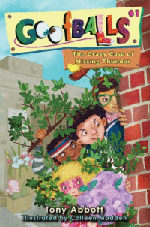 Beginning the new series, Goofballs, Abbott’s characters Jeff, the narrator, and Brian, Mara, and Kelly are the cast members in this new series sure to abound with mystery and a few touches of slapstick humor and wordplay en route to solving the first case, that of the missing horse, Thunder. These kids have been friends since first grade and have enjoyed solving many of the town’s little mysteries. As their reputation as grown, as well as their self-proclaimed goofball methods of following clues, wealth Randall Crandall approaches them to find his missing horse. As the gang looks for clues, Jeff carefully keeps track of everything in his ever-present clue notebook. A flower delivery truck, a few crunched, munched flowers lead the crew to a flower shop where they disguise themselves as bushes to be on the lookout for more clues. This early reader chapter book is accompanied by the drawings of Colleen Madden that add to the humor and the fact that Goofballs have a multicultural and mixed gender makeup, it makes the book even that more appealing. Emerging readers will anxiously await the rest of the rollicking series. Visit the author’s website for more about his books and writing:
Beginning the new series, Goofballs, Abbott’s characters Jeff, the narrator, and Brian, Mara, and Kelly are the cast members in this new series sure to abound with mystery and a few touches of slapstick humor and wordplay en route to solving the first case, that of the missing horse, Thunder. These kids have been friends since first grade and have enjoyed solving many of the town’s little mysteries. As their reputation as grown, as well as their self-proclaimed goofball methods of following clues, wealth Randall Crandall approaches them to find his missing horse. As the gang looks for clues, Jeff carefully keeps track of everything in his ever-present clue notebook. A flower delivery truck, a few crunched, munched flowers lead the crew to a flower shop where they disguise themselves as bushes to be on the lookout for more clues. This early reader chapter book is accompanied by the drawings of Colleen Madden that add to the humor and the fact that Goofballs have a multicultural and mixed gender makeup, it makes the book even that more appealing. Emerging readers will anxiously await the rest of the rollicking series. Visit the author’s website for more about his books and writing:
- Karen Hildebrand, Ohio Library and Reading Consultant
Boyd, Lizi. (2013). Inside Outside. San Francisco: Chronicle Books.
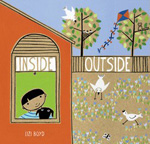 Lizi Boyd has used visual play WITHOUT words for this delightful peek into what is going on inside and outside as the story opens on this wintery day. Die-cut windows allow the reader to see and predict what is happening through these windows. Careful observers will notice two white mice hiding within each double page spread and also that the seasons are changing. Look through the windows and watch how the weather changes or how the windows frame one thing that turns into something completely different when the page is turned! The end papers and paper quality of each page add to the beauty of this book. This is a book readers/viewers will return to again and again to discover new things in the windows that they did not see the first time around.
Lizi Boyd has used visual play WITHOUT words for this delightful peek into what is going on inside and outside as the story opens on this wintery day. Die-cut windows allow the reader to see and predict what is happening through these windows. Careful observers will notice two white mice hiding within each double page spread and also that the seasons are changing. Look through the windows and watch how the weather changes or how the windows frame one thing that turns into something completely different when the page is turned! The end papers and paper quality of each page add to the beauty of this book. This is a book readers/viewers will return to again and again to discover new things in the windows that they did not see the first time around.
Visit the author’s website for a look at her creative work:
- Karen Hildebrand, Ohio Library and Reading Consultant
Brennan-Nelson, Denise. (2012). Maestro Stu saves the zoo. Illus. by Tim Bowers. Ann Arbor, MI: Sleeping Bear Press.
 Young Stu has lived next to the zoo his whole life and has grown up listening to the noises and sounds coming from all the animals within. His mother has always called these sounds her symphony. One day, a sleazy businessman sets out to woo the city managers to see the zoo so he can build a mall on that same spot. The people in charge are definitely taken with the plan, even more taken with the bribes and gifts this Mr. Cooper is handing out. When the animals learn about their demise, they have a midnight meeting to decide what they can do about it. Stu hears about the meeting and so attends, too, because he has an idea. When the meeting opens, the animals are fretful and it is at this point in the story the idioms come pouring out. “We’re all ears,” “our hands our tied,” “wore her heart on her sleeve,” “mountain out of a molehill” are just some of the idiomatic phrases. Stu directs the animals in a true symphony of sound that the whole town notices and enjoys. As people flock to the zoo, the zoo is saved from becoming a mall. Though the storyline is quite simple and very problematic, even a bit didactic, teachers who need a read aloud to give an example of various uses of idioms, this book might be helpful. The author has listed the idioms in the back with definitions. Tim Bowers’ illustrations are a most enjoyable part of the book, as young readers will enjoy the facial expressions on each animal throughout the story. Listen and watch the author as she introduces this book, complete with animal sounds, and reads from it and find a teachers’s guide for Maestro Stu. Read more about this author in her column on the Engage blog.
Young Stu has lived next to the zoo his whole life and has grown up listening to the noises and sounds coming from all the animals within. His mother has always called these sounds her symphony. One day, a sleazy businessman sets out to woo the city managers to see the zoo so he can build a mall on that same spot. The people in charge are definitely taken with the plan, even more taken with the bribes and gifts this Mr. Cooper is handing out. When the animals learn about their demise, they have a midnight meeting to decide what they can do about it. Stu hears about the meeting and so attends, too, because he has an idea. When the meeting opens, the animals are fretful and it is at this point in the story the idioms come pouring out. “We’re all ears,” “our hands our tied,” “wore her heart on her sleeve,” “mountain out of a molehill” are just some of the idiomatic phrases. Stu directs the animals in a true symphony of sound that the whole town notices and enjoys. As people flock to the zoo, the zoo is saved from becoming a mall. Though the storyline is quite simple and very problematic, even a bit didactic, teachers who need a read aloud to give an example of various uses of idioms, this book might be helpful. The author has listed the idioms in the back with definitions. Tim Bowers’ illustrations are a most enjoyable part of the book, as young readers will enjoy the facial expressions on each animal throughout the story. Listen and watch the author as she introduces this book, complete with animal sounds, and reads from it and find a teachers’s guide for Maestro Stu. Read more about this author in her column on the Engage blog.
- Karen Hildebrand, Ohio Library and Reading Consultant
Hall, Michael. (2012). Cat tale. New York: HarperCollins/Greenwillow Books.
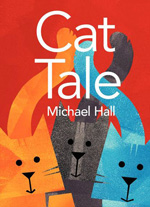 The word fun begins with the title of this book since it could be a feline-centered story or the story of a cat’s appendage. Three curious cats--Lillian, Tilly, and William J.--busily chase homonyms and homophones across the pages of this book, starting with "kitty chews"/"choose a spot" (unpaged). Young readers will enjoy the continuous word play that moves from page to page. The felines are having so much fun as they race through the book until they became discombobulated and have to start anew, beginning this time with "tale"/"tail" (unpaged). The brightly colored illustrations created with acrylic painted textures and paper cutouts that have been combined digitally add to the book’s playfulness. Smiles are guaranteed once readers reach the page featuring three cats' tails of different hue as each cat heads off for more word play fun. This cleverly written book is perfect for a read aloud and an excellent writing mentor text.
The word fun begins with the title of this book since it could be a feline-centered story or the story of a cat’s appendage. Three curious cats--Lillian, Tilly, and William J.--busily chase homonyms and homophones across the pages of this book, starting with "kitty chews"/"choose a spot" (unpaged). Young readers will enjoy the continuous word play that moves from page to page. The felines are having so much fun as they race through the book until they became discombobulated and have to start anew, beginning this time with "tale"/"tail" (unpaged). The brightly colored illustrations created with acrylic painted textures and paper cutouts that have been combined digitally add to the book’s playfulness. Smiles are guaranteed once readers reach the page featuring three cats' tails of different hue as each cat heads off for more word play fun. This cleverly written book is perfect for a read aloud and an excellent writing mentor text.
- Barbara A. Ward, Washington State University Pullman
Klausmeier, Jesse. (2013). Open this little book. Illus. by Suzy Lee. San Francisco: Chronicle Books.
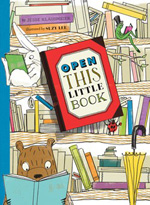 This book is cleverly designed, intended to tell several stories at once, eight different ones in all. As readers open each book, they find another, smaller book, and a storyline running through each one. One of the best parts of the books is how each book cover mirrors some element and color in the book's content; for instance, Little Green Book features lily pads on its cover and lily pads and frogs within its story. There is also a friendship theme running through the book since the animal friends reading the books frolic together, and then, when Giant's hand is too large to open her tiny book, her friends help her. The fact that each story continues on the other side of the page until the conclusion of each story has been reached adds to the delight of reading this title. Filled with pencil and watercolor illustrations created with soft colors and then digitally manipulated this title is a tribute to bibliophiles who can never get enough of a good thing and word lovers who enjoy simple stories well told. Readers' fingers will get quite a work out when they open this book. It’s a sure bet that they’ll want to open it more than once.
This book is cleverly designed, intended to tell several stories at once, eight different ones in all. As readers open each book, they find another, smaller book, and a storyline running through each one. One of the best parts of the books is how each book cover mirrors some element and color in the book's content; for instance, Little Green Book features lily pads on its cover and lily pads and frogs within its story. There is also a friendship theme running through the book since the animal friends reading the books frolic together, and then, when Giant's hand is too large to open her tiny book, her friends help her. The fact that each story continues on the other side of the page until the conclusion of each story has been reached adds to the delight of reading this title. Filled with pencil and watercolor illustrations created with soft colors and then digitally manipulated this title is a tribute to bibliophiles who can never get enough of a good thing and word lovers who enjoy simple stories well told. Readers' fingers will get quite a work out when they open this book. It’s a sure bet that they’ll want to open it more than once.
- Barbara A. Ward, Washington State University Pullman
Rosenthal, Amy Krouse. (2012). I Scream! Ice Cream! A book of Wordles. Illus. by Serge Bloch. San Francisco: Chronicle Books.
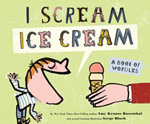 Although some of these creative wordles are more enjoyable than the others that require a second or third thought and some are rather clunky, overall, this book is a treat for word lovers. Wordles are defined as "groups of words that sound exactly the same but mean different things" (unpaged), and this book is filled with them. Readers will love trying them out; for example, “heroes/he rows” or “I see/icy/ Aye, sea!” (unpaged). It’s a toss-up as to whether someone will scream for more ice cream or more word fun after reading this one. Accompanied by lively illustrations, this title is a must-have for anyone who loves words. Plus, young readers will want to try their hands at creating some wordles of their own. Teachers will enjoy using the online Wordle tool.
Although some of these creative wordles are more enjoyable than the others that require a second or third thought and some are rather clunky, overall, this book is a treat for word lovers. Wordles are defined as "groups of words that sound exactly the same but mean different things" (unpaged), and this book is filled with them. Readers will love trying them out; for example, “heroes/he rows” or “I see/icy/ Aye, sea!” (unpaged). It’s a toss-up as to whether someone will scream for more ice cream or more word fun after reading this one. Accompanied by lively illustrations, this title is a must-have for anyone who loves words. Plus, young readers will want to try their hands at creating some wordles of their own. Teachers will enjoy using the online Wordle tool.
- Barbara A. Ward, Washington State University Pullman
Sayre, April Pulley. (2012). Go, go, grapes!: A fruit chant. New York: Simon & Schuster/Beach Lane Books.
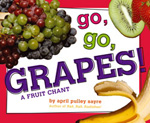 Anyone who enjoyed the author's earlier title, Rah, Rah, Radishes!: A Vegetable Chant (2011), will be equally enchanted by this delightful title. Imaginatively thinking up chants for fruits that are good to eat, the author encourages an enthusiastic embrace of healthy food offerings amid fun-to-say chants. The photographs show all sorts of yummy fruits that can be picked up at local food markets. All in all, this book is a sweet (and healthy) treat celebrating fruits that are somewhat unfamiliar and words that taste good on the tongue. What more could a reader want?
Anyone who enjoyed the author's earlier title, Rah, Rah, Radishes!: A Vegetable Chant (2011), will be equally enchanted by this delightful title. Imaginatively thinking up chants for fruits that are good to eat, the author encourages an enthusiastic embrace of healthy food offerings amid fun-to-say chants. The photographs show all sorts of yummy fruits that can be picked up at local food markets. All in all, this book is a sweet (and healthy) treat celebrating fruits that are somewhat unfamiliar and words that taste good on the tongue. What more could a reader want?
- Barbara A. Ward, Washington State University Pullman
Smith, Maggie. (2012). Pigs in pajamas. New York: Random House/Alfred A. Knopf.
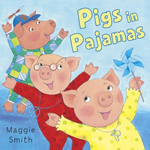 This playful title teaches young readers various concepts such as colors, shapes, patterns, and counting through amusing illustrations. Images of pigs wearing pajamas introduce the letter p. The story is set during a sleepover party on a Saturday night at Penelope Pig’s home. Everyone brings presents for Penelope, but the presents all start with the same letter. Thus, she receives peppermints, posies, and peach lollipop. The guests dine on punch, pies, and pudding. They also have pasta with pickles on top. The party features pin-the-tail-on the donkey and a piñata to whack. Dancing through the night, the six pigs in pajamas have fun until they too pooped to play or even make a peep. The tired pigs have finally fallen asleep. Featuring illustrations of 75 objects beginning with the letter p for readers to identify, this book is a great aid in practicing pronunciation and developing fluency.
This playful title teaches young readers various concepts such as colors, shapes, patterns, and counting through amusing illustrations. Images of pigs wearing pajamas introduce the letter p. The story is set during a sleepover party on a Saturday night at Penelope Pig’s home. Everyone brings presents for Penelope, but the presents all start with the same letter. Thus, she receives peppermints, posies, and peach lollipop. The guests dine on punch, pies, and pudding. They also have pasta with pickles on top. The party features pin-the-tail-on the donkey and a piñata to whack. Dancing through the night, the six pigs in pajamas have fun until they too pooped to play or even make a peep. The tired pigs have finally fallen asleep. Featuring illustrations of 75 objects beginning with the letter p for readers to identify, this book is a great aid in practicing pronunciation and developing fluency.
- Rani Iyer, Washington State University Pullman
Grades 3-6
Loewen, Nancy. (2011). She sells seashells and other tricky tongue twisters. Illus. by Donald Wu. Mankato, MN: Picture Window Books/Capstone Press.
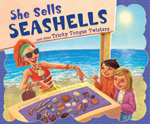 This picture book opens with the question, “What is a tongue twister?” (p.2) The next page goes on to explain what a tongue twister is “when we talk, our brain, tongue, and lips have to work together in the right way. Most of the time, it just happens. But every so often, there’s a glitch. The wrong sounds come out. Our tongues “twist.” Tongue twisters make our tongues twist on purpose. They a challenge for our tongue, brain and everything in between!” (p.3) The book continues with a young boy named Ken who moves through his day at school. Interspersed throughout the story are fact boxes about tongue twisters, how they can be useful especially to those learning English to practice words, but also examples of homophones and rhythm as these words play with tongue twisting activity. This book will be a helpful teaching tool in a word study and includes activities, websites and other books to read at the end.
This picture book opens with the question, “What is a tongue twister?” (p.2) The next page goes on to explain what a tongue twister is “when we talk, our brain, tongue, and lips have to work together in the right way. Most of the time, it just happens. But every so often, there’s a glitch. The wrong sounds come out. Our tongues “twist.” Tongue twisters make our tongues twist on purpose. They a challenge for our tongue, brain and everything in between!” (p.3) The book continues with a young boy named Ken who moves through his day at school. Interspersed throughout the story are fact boxes about tongue twisters, how they can be useful especially to those learning English to practice words, but also examples of homophones and rhythm as these words play with tongue twisting activity. This book will be a helpful teaching tool in a word study and includes activities, websites and other books to read at the end.
“Ways to Say It” series. Visit the author’s website.
- Karen Hildebrand, Ohio Library and Reading Consultant
Loewen, Nancy. (2011). Stubborn as a mule and other silly similes. Illus. by Adam Watkins. Mankato, MN: Picture Window Books/Capstone Press.
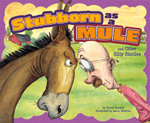 This series has a similar format in each book, beginning with the question, in this case, “What is a simile?” (p.2) A definition with examples follows on page 3. The picture book storyline begins with Mr. Moe who is “as bald as an egg.” (p.5) In speech bubbles around the page, explanations are given explaining how a simile compares one thing to another and the example is on the page illustrated in a way that is clearly understood. As Mr. Moe goes about his day, more similes appear on each double page spread with the speech bubbles and fact boxes giving references to further understanding. The end of the book includes an activity, glossary, websites and further reading. Teachers will find this a resource for a read aloud to give examples of similes with a twist of humor.
This series has a similar format in each book, beginning with the question, in this case, “What is a simile?” (p.2) A definition with examples follows on page 3. The picture book storyline begins with Mr. Moe who is “as bald as an egg.” (p.5) In speech bubbles around the page, explanations are given explaining how a simile compares one thing to another and the example is on the page illustrated in a way that is clearly understood. As Mr. Moe goes about his day, more similes appear on each double page spread with the speech bubbles and fact boxes giving references to further understanding. The end of the book includes an activity, glossary, websites and further reading. Teachers will find this a resource for a read aloud to give examples of similes with a twist of humor.
- Karen Hildebrand, Ohio Library and Reading Consultant
Loewen, Nancy. (2011). Talking turkey and other clichés we say. Illus. by Adam Watkins. Mankato, MN: Picture Window Books/Capstone Press.
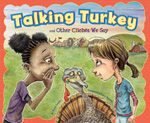 As is the pattern in the other “Ways to Say It” series, this picture book opens with the question “What is a cliché?” (p.2) After a definition and introduction are given, the actual story is launched with Faye and Trish who are introduced as best friends, “true blue” and “thick as thieves.” (p.5) The girls are on their way to the county fair to hear the concert by the Bonus Brothers. Before the concert the girls ride some of the scary fair rides and enjoy cotton candy, hot dogs and milkshakes and visit the petting zoo. All the while they are checking to make sure they still have their concert tickets though they realize after all their activity, the tickets have gotten crushed. “The bottom has dropped out of their world.”(p.17) At that moment, three long skinny pairs of legs appear saying, “Don’t hit the panic button,” “ We’ve got you covered.” (p.19) It’s the Bonus Brothers! The give the girls new tickets AND autographs! The concert is a “blast” and a “dream come true.” The Bonus Brothers really “Rock!” (p.22) The end of the book includes a game of cliché charades, a glossary, websites, and other books for suggested reading. Teachers will find this a humorous read aloud to introduce and explain the use of clichés.
As is the pattern in the other “Ways to Say It” series, this picture book opens with the question “What is a cliché?” (p.2) After a definition and introduction are given, the actual story is launched with Faye and Trish who are introduced as best friends, “true blue” and “thick as thieves.” (p.5) The girls are on their way to the county fair to hear the concert by the Bonus Brothers. Before the concert the girls ride some of the scary fair rides and enjoy cotton candy, hot dogs and milkshakes and visit the petting zoo. All the while they are checking to make sure they still have their concert tickets though they realize after all their activity, the tickets have gotten crushed. “The bottom has dropped out of their world.”(p.17) At that moment, three long skinny pairs of legs appear saying, “Don’t hit the panic button,” “ We’ve got you covered.” (p.19) It’s the Bonus Brothers! The give the girls new tickets AND autographs! The concert is a “blast” and a “dream come true.” The Bonus Brothers really “Rock!” (p.22) The end of the book includes a game of cliché charades, a glossary, websites, and other books for suggested reading. Teachers will find this a humorous read aloud to introduce and explain the use of clichés.
- Karen Hildebrand, Ohio Library and Reading Consultant
Loewen, Nancy. (2011). You’re toast and other metaphors we adore. Illus. by Donald Wu. Mankato, MN: Picture Window Books/Capstone Press.
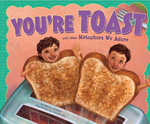 One more title from the “Ways to Say It” series is You’re Toast, this time discussing metaphors. Using the now-familiar pattern that begins each book with the question, “What is a metaphor?”, the definition and examples follow in the opening pages. Cory and his younger sister Etta are facing the last piece of Grandma Greta’s fabulous blueberry pie. “The blueberries are as fast as Ping-Pong balls.” (p.5) When the siblings agree that they cannot share the pie as each one wants the entire piece, Grandma suggests that they will have to win it. Cory wins a running race, and the spinning race, but Etta is the first to find a hidden spool of thread as well as winning a basketball game of HORSE. Grandma says the last race is a word game asking each of her grandchildren to make as many words as they can from the phrase “blueberry pie.” Etta wins with seven words. They head for the kitchen to claim the winning piece of pie only to discover their father sitting there swallowing the last bite. Grandma solves the dilemma by announcing they will just make another pie. Sprinkled throughout the story the author has embedded metaphors of all kinds. Speech bubbles and fact boxes give explanations and a bit of history about metaphors. Another in the series recommended for teachers to use as a read aloud for students to hear metaphors in everyday language. A metaphor game, other activities, weblinks, and a glossary are included at the end of the book.
One more title from the “Ways to Say It” series is You’re Toast, this time discussing metaphors. Using the now-familiar pattern that begins each book with the question, “What is a metaphor?”, the definition and examples follow in the opening pages. Cory and his younger sister Etta are facing the last piece of Grandma Greta’s fabulous blueberry pie. “The blueberries are as fast as Ping-Pong balls.” (p.5) When the siblings agree that they cannot share the pie as each one wants the entire piece, Grandma suggests that they will have to win it. Cory wins a running race, and the spinning race, but Etta is the first to find a hidden spool of thread as well as winning a basketball game of HORSE. Grandma says the last race is a word game asking each of her grandchildren to make as many words as they can from the phrase “blueberry pie.” Etta wins with seven words. They head for the kitchen to claim the winning piece of pie only to discover their father sitting there swallowing the last bite. Grandma solves the dilemma by announcing they will just make another pie. Sprinkled throughout the story the author has embedded metaphors of all kinds. Speech bubbles and fact boxes give explanations and a bit of history about metaphors. Another in the series recommended for teachers to use as a read aloud for students to hear metaphors in everyday language. A metaphor game, other activities, weblinks, and a glossary are included at the end of the book.
- Karen Hildebrand, Ohio Library and Reading Consultant
Not yet published, but coming this spring are four more amusing books with wordplay and fun:
- I love ewe; an ode to animal moms by Aaron Zenz (Walker, March 2013)
- Hug a bull; an ode to animal dads by Aaron Zenz (Walker, April 2013)
- My new teacher and me by Al Yankovic (HarperCollins, June 2013)
- Spike and Ike take a hike by S.D. Schindler (Nancy Paulsen books, April 2013)
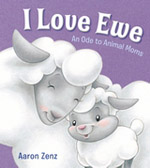


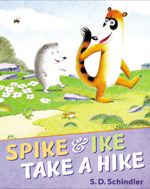
These reviews are submitted by members of the International Reading Association's Children's Literature and Reading Special Interest Group (CL/R SIG) and are published weekly on Reading Today Online. The International Reading Association partners with the National Council of Teachers of English and Verizon Thinkfinity to produce ReadWriteThink.org, a website devoted to providing literacy instruction and interactive resources for grades K–12.